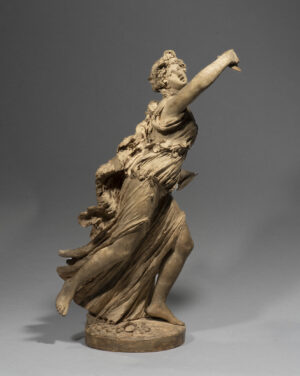Joseph-Charles MARIN
(1759-1834)
It is easy to trace the young sculptor’s first years of training. More than ten regulatory re-enrolments, until 1786, tell us he regularly attended the Académie Royale de Peinture et de Sculpture. Joseph-Charles Marin first registered as a sculptor on March 31, 1778, at the age of nineteen, under the protection of (Augustin?) Pajou. A Young girl lying down, holding a rose, signed and dated 1778 (Marius Paulme sale, May 15, 1929) was to be his first known terracotta.
From 1782 to 1787, in spite of six successive attempts he failed to obtain the Premier Grand Prix de sculpture and he disappeared from the school’s registers until 1799. In 1791, Marin nevertheless exhibited at the Salon, for the first time, eleven ‘pieces of sculpture’, artworks which well reflected his repertoire, under a single number, 493. Let us mention among others, Two small terracotta heads, Bacchante with two children, Bacchante, Vestal, Sacrifice to Cérès (a terracotta bas-relief)… The artist then showed up a dozen times at the Salons, until 1833.
In 1794, endowed with an annuity after his mother’s death, he left for Rome, at his own expense, where he stayed until 1799. Created during his first sojourn in Italy, is a naked Bacchante, standing, pressing a bunch of grapes in a cup, signed and dated 1797 (Kraemer sale, April 29, 1913, No 132). In 1800, Marin was admitted as logiste to the final examination for the Grand Prix de Sculpture, its subject being Priam asking Achilles to return the body of Hector, his son. But no Grand Prix was awarded then. It was the following year he finally won it, with his Caius Gracchus leaving his wife Licinia to join his disciples(plaster bas-relief, Paris, École nationale Supérieure des Beaux-Arts). From September 23, 1802 to September 23, 1807, Joseph-Charles Marin, Grand Prix, was a resident at the Académie de France in Rome. His stay at the Villa Médicis made him happy and gave a spur to his creativity. From his very first year there, the sculptor planned to produce around fifty original or antique-inspired terracotta compositions and a thousand sketches on paper. Displayed in 1805,his Telemachus sheperd earned him to be unanimously admitted at the Académie de Saint-Luc in Rome as well as to be appointed professor at Canova’s suggestion. It was at this turning point that the sculptor changed his style, from amiable to severe. He somewhat forsook his delicate statuettes to work on private commissions of busts and funeral monuments.
Among the works sent to Paris for the 1808 Salon, his Bather was hailed by the Académie (Paris, Musée du Louvre – RF 2617).
Landon reproduced the work and commented on it in the ‘Annales du Musée’: “This new statue can but add to his renown; it heralds a higher style, a purer taste, more grandiose forms”. On his return to Paris in 1812, Marin carried out models, at his own expense, for important unfinished works such as the colossal statue of Religion for the summit of the Pantheon’s dome, or four large figures for a fountain and a large bas-relief for the Arc de Triomphe. On September 25, 1813, he was appointed professor of Sculpture at the Ecole de Dessin of Lyon to replace Chinard. He resigned on July 23, 1817 and went to Paris where the Maréchal de Gouvion-saint-Cyr, who had become his patron, asked him to restore the baldaquin of the Invalides’s Dome. At the 1819 Salon, he exhibited numerous works. In 1827, he sculpted a posthumous bust of Vivant Denon for the galleries of the Musée du Louvre, then in 1828, a bust of the Dauphin, and in 1829 one of the Duc d’Angoulême for the town of Chaumont. In 1830, then 71 years old, he continued to work for a private clientele of amateurs and “gave lessons of his art”. However it was in poverty that the sculptor, Joseph-Charles Marin, died on September 19, 1834 at 95, rue Neuve-de-seine.

